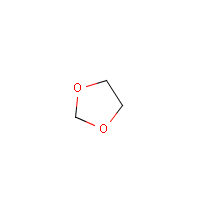1,3-Dioxolane
Agent Name
1,3-Dioxolane
Alternative Name
Formal glycol
CAS Number
646-06-0
Formula
C3-H6-O2
Major Category
Solvents

Synonyms
1,3-Dioxacyclopentane; 1,3-Dioxolan; 1,3-Dioxole, dihydro-; Dioxolan [Czech]; Dioxolane; Ethylene glycol formal; Formal glycol; Glycol formal; Glycol methylene ether; Glycolformal; [ChemIDplus]
Category
Ethers (<C12)
Description
Colorless liquid with a mild, ethereal odor; [ACGIH]
Sources/Uses
Used as a solvent and extractant for fats, waxes, and dyes; Used in the production of phenolic-novolak resins; [HSDB] Used as a monomer to produce polyacetals and a solvent for polyesters, vinyls, and epoxys; May be used as a paint stripper; [ACGIH]
Comments
In animal studies, 1,3-dioxolane is a CNS depressant and has some effects on the liver; [HSDB] A skin irritant and severe eye irritant; Blood (leukopenia) and reproductive changes occur in animal studies. [ACGIH]
Biomedical References
Exposure Assessment
Skin Designation (ACGIH)
No
TLV (ACGIH)
20 ppm
MAK
50 ppm
Vapor Pressure
79 mm Hg
Lethal Concentration
LC50 (rat) = 20,650 mg/m3/4H
Explanatory Notes
VP from ChemIDplus;
NFPA
may ignite at ambient temp
Adverse Effects
Neurotoxin
Acute solvent syndrome
Hepatotoxin
Hepatoxic (a) from occupational exposure (secondary effect) or (b) in animal studies or in humans after ingestion
Reproductive Toxin
Yes
Diseases, Processes, and Activities Linked to This Agent
Diseases
Occupational diseases associated with exposure to this agent:
Processes
Industrial Processes with risk of exposure: